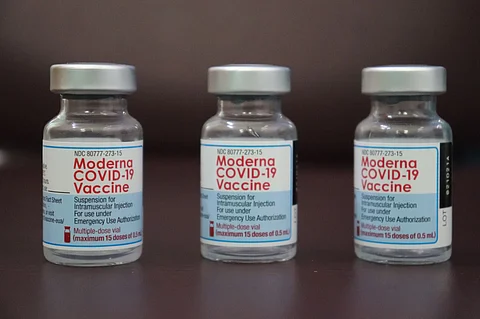

A health physicist at a national US laboratory found Moderna never tested its COVID-19 mRNA SPIKEVAX for where it would go in the body, but the US Food and Drug Administration accepted a Moderna study of a different drug in its place.
The findings were published Tuesday in a report by Linnea Wahl for the DailyClout. Wall is a health physicist at Lawrence Berkeley National Labratory in California. Her report is the 91st in a series based on court-mandated disclosures by the FDA on the documents they had when approving the mRNA COVID-19 vaccines.
The documents reveal an FDA reviewer specifically stated, “A biodistribution study was not performed with mRNA-1273 vaccine [SPIKEVAX]. Results from the biodistribution study of a different vaccine . . . were submitted in support of SPIKEVAX.”
Moderna researchers tested this completely different mRNA product in the blood of rats and examined its distribution in 13 different body tissues. Despite this substitution, on December 18, 2020, the FDA authorized emergency use of Moderna’s COVID-19 mRNA drug and granted full approval Jan. 31, 2022.
Before the FDA approves a new drug for human use, manufacturers need to show where the drug goes in the body, how long it stays there, and how it is removed.
Typically, a group of test animals, such as mice, rats, or monkeys, receive the same drug at the same dosage that is proposed for use in humans. At regular intervals, researchers sacrifice a subset of the animals and examine how much of the drug has reached each tissue. A drug that biodistributes to organs outside of its intended purpose may not be safe for human use.
The FDA recommends biodistribution studies for proposed drugs that involve gene therapy. This is why Moderna performed a biodistribution study in 2017 on their experimental drug (mRNA-1647) against cytomegalovirus (CMV).
In a loophole, the FDA excludes 'vaccines' from requiring biodistribution studies even if they include gene therapy mRNA. Consequently, the researchers submitted the results of a study on a different mRNA drug (mRNA-1647) and asked FDA reviewers to accept it in place of one on mRNA-1273 (SPIKEVAX).
Moderna researchers told FDA reviewers SPIKEVAX would distribute throughout our bodies in the same way because the two drugs use the same lipid nanoparticle formulation to encapsulate mRNA.
But Wahl reports, “the substituted biodistribution study itself did not show anything like safety. The materials injected into the rats went everywhere.”
The substitute biodistribution study was conducted from August 23 through September 7, 2017. Here, Moderna researchers injected 35 male rats with the CMV mRNA vaccine. At seven timed intervals (0, 2, 8, 24, 48, 72, and 120 hours), researchers sacrificed five rats to analyze their blood and tissues for the injected mRNA.
Tissues from 13 organs were examined: lung, liver, heart, kidney, lymph nodes, spleen, brain, stomach, testes, eye, bone marrow, intestine and injection site muscle. Blood samples were also taken.
The CMV mRNA drug distributed to the blood and all organs except kidneys within two to eight hours after injection. The spleen and the eye tissues had the mRNA at greater levels than in the blood, suggesting that the drug concentrated there.
Despite such wide distribution of this drug throughout rats’ bodies, the FDA reviewers accepted this study as proof that Moderna’s SPIKEVAX was safe for humans.
“Are the two drugs similar enough to support Moderna’s claim that they distribute throughout the body in the same way? No. There are important differences between the two mRNA drugs,” Wahl wrote.
“In SPIKEVAX, the LNP capsule has four lipid components [including]...SM-102,...Much less is known about the LNP capsule of Moderna’s CMV mRNA drug. Moderna admits only that the CMV mRNA drug is encased in an LNP shell that contains their 'standard proprietary' SM-102-ionizable lipid.”
The genetic content is also different, Wahl explains. And size differences alone have been shown to affect “liver uptake and accumulation and kidney excretion.”
“In SPIKEVAX, the contents of the LNP shell are the genetic sequence that codes for the SARS-CoV-2 spike protein. By contrast, Moderna’s CMV mRNA drug consists of six different genetic sequences, all of which code for CMV proteins,” Wahl said.
“Do the LNP particles of Moderna’s CMV and COVID-19 mRNA drugs biodistribute similarly? The FDA reviewers did not ask…Moderna replaced apples with oranges.
Because no female rats were injected, the possibility that SPIKEVAX or its substitute would concentrate in ovaries was never established.
Helene Banoun made similar observations last June in a paper for the International Journal for Molecular Science. “The wide and persistent biodistribution of mRNAs and their protein products, incompletely studied due to their classification as vaccines, raises safety issues,” she wrote.
